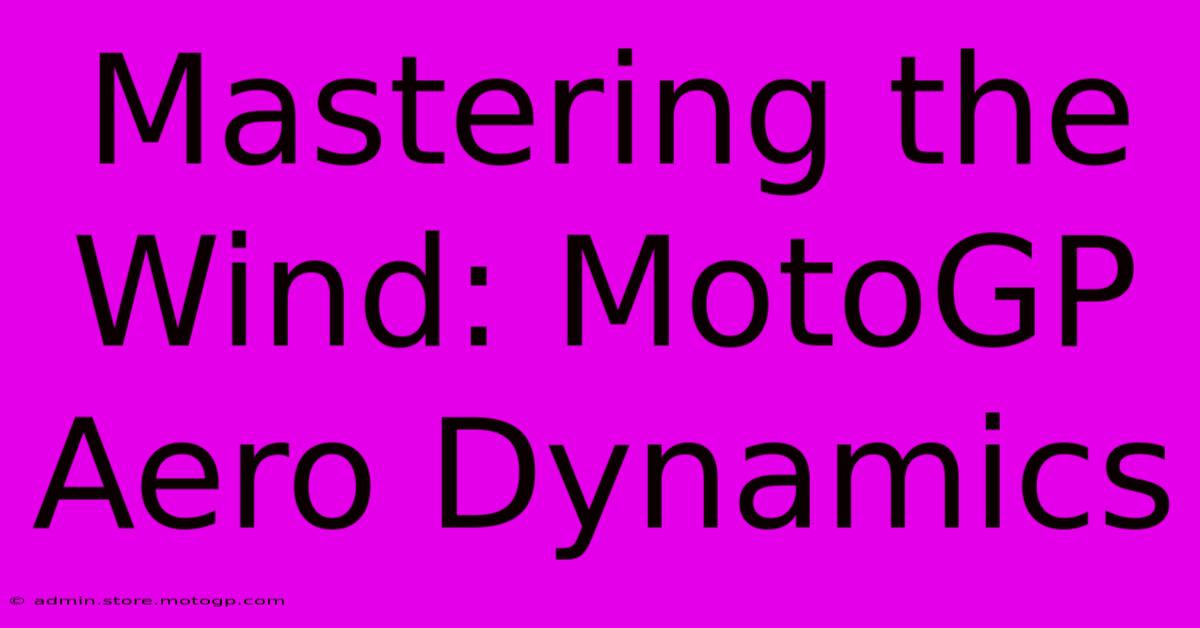Mastering The Wind: MotoGP Aero Dynamics

Table of Contents
Mastering the Wind: MotoGP Aero Dynamics
MotoGP, the pinnacle of motorcycle road racing, is a relentless battle for milliseconds. Every advantage counts, and in recent years, aerodynamic performance has become a crucial factor separating the winners from the also-rans. This article delves into the fascinating world of MotoGP aero dynamics, exploring the science behind the wings, winglets, and other aerodynamic devices that shape the race.
The Science of Speed: Understanding Aerodynamic Principles in MotoGP
MotoGP bikes, traveling at speeds exceeding 200 mph (320 km/h), experience significant aerodynamic forces. These forces, primarily drag and downforce, drastically impact performance.
Drag: This resistive force opposes the bike's motion, slowing it down. Minimizing drag is paramount for achieving higher top speeds.
Downforce: This is the force pushing the bike towards the track surface. While it increases drag slightly, the benefit of improved stability and cornering speeds far outweighs this drawback. Downforce allows riders to brake later, accelerate sooner, and lean further into corners without losing control.
The Evolution of Aerodynamics in MotoGP
Early MotoGP bikes relied heavily on rider skill to manage high speeds and cornering forces. However, as speeds increased, the need for advanced aerodynamic solutions became apparent.
- Early Winglets: Initially, small winglets began appearing, offering a modest increase in downforce.
- Larger Wings & Aerodynamic Appendages: The evolution led to larger, more sophisticated wings and various aerodynamic appendages strategically placed on the fairings and swingarms. These components are carefully designed to generate precisely controlled downforce.
- Computational Fluid Dynamics (CFD): Sophisticated computer simulations, known as CFD, play a vital role in the design and optimization of aerodynamic components. These simulations allow engineers to test and refine designs virtually before physical prototyping, saving valuable time and resources.
- The Constant Arms Race: The competition between manufacturers drives continuous innovation in MotoGP aerodynamics. Teams constantly strive to find even marginal improvements in downforce and drag reduction, leading to ever-evolving designs.
Key Aerodynamic Components in Modern MotoGP Bikes
Modern MotoGP machines boast a range of aerodynamic components working in concert:
- Front Wings/Winglets: These are crucial for generating downforce at the front, improving stability and reducing the tendency for wheelies under acceleration.
- Side Fairings and Bodywork: The design of the fairing significantly impacts airflow around the bike. Smooth surfaces and strategically placed vents minimize drag while directing airflow to maximize downforce.
- Rear Wings: Similar to front wings, these generate significant downforce at the rear, improving traction and stability during braking and cornering.
- Underbody Aerodynamics: The underbody of the bike is also carefully designed to manage airflow. Diffusers and other features are used to create a low-pressure area beneath the bike, contributing to downforce.
- Swingarm Aerodynamics: Even the swingarm is incorporated into the overall aerodynamic design. Strategic shaping of the swingarm can influence airflow and contribute to stability.
The Rider's Role in Aerodynamic Performance
While the engineering is crucial, the rider's skill plays a vital role in harnessing the aerodynamic capabilities of the bike. The rider's posture, body position, and even subtle movements influence airflow around the bike, affecting both drag and downforce.
The Future of MotoGP Aero Dynamics
The quest for aerodynamic perfection is ongoing. Future developments may include:
- Active Aerodynamics: Systems that adjust aerodynamic components in real-time based on speed, track conditions, and rider input.
- More Sophisticated CFD Modeling: Even more precise computer simulations to push the boundaries of aerodynamic performance.
- Lightweight Materials: Using lighter materials allows for greater performance without sacrificing aerodynamic efficiency.
Conclusion:
Mastering the wind is a crucial aspect of MotoGP success. The sophisticated science of aerodynamics, combined with the rider's skill, allows for breathtaking speeds and cornering abilities. The constant push for innovation ensures that the future of MotoGP aerodynamics will remain as exciting and captivating as the racing itself. The evolution of aerodynamic solutions in MotoGP is a testament to human ingenuity and the ongoing quest for speed.

Thank you for visiting our website wich cover about Mastering The Wind: MotoGP Aero Dynamics. We hope the information provided has been useful to you. Feel free to contact us if you have any questions or need further assistance. See you next time and dont miss to bookmark.
Featured Posts
-
F1 Qualifying The Heart Stopping Race For Pole
Feb 18, 2025
-
Gp Results The Importance Of Regular Checkups
Feb 18, 2025
-
The Moto Gp Hall Of Fame Honoring The Best
Feb 18, 2025
-
Experience The Power Of Lot R Cota
Feb 18, 2025
-
Moto Gp Streams Essential Tips For Smooth Viewing
Feb 18, 2025
